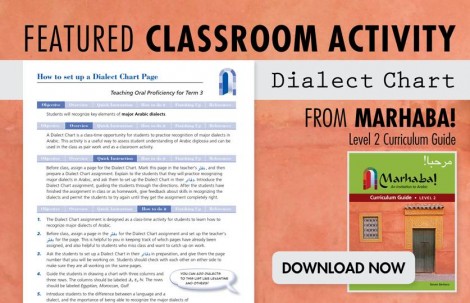 image source: http://bit.ly/1ou6Zjw
image source: http://bit.ly/1ou6Zjw
One of the first things I learned while studying Arabic was that Arabic was not a single language. It’s normal for most languages to have different forms; the written form may often differ from the spoken form, for example. In Arabic, it’s unique, in that it is sort of a conglomeration of 4 different languages. In 1959, the sociolinguist Charles Ferguson labeled Arabic as a diglossic language. In his article, he examined 4 different languages (Arabic, Haitian Creole/French, Greek and Swiss German), and proposed that within each one of these languages there exists two forms, a high form and a low form. He explains it as such:
”Diglossia is a relatively stable language situation in which, in addition to the primary dialect of the language (which may include standard or regional standards), there is a very highly codified (often grammatically complex) superposed variety.”
These two forms, he goes on to say, are both used by small groups within their respective societies and are distributed throughout the larger society as a whole. He made it clear that each one had specific and appropriate times of usage. These times of usage were understood and conformed to by the society. To support this claim he provided some examples: the high form was usually regarded as being very prestigious, used for formal conversation, and usually had a large amount of literature attached to it. The low form, on the other hand, was typically relegated to everyday, intimate conversation, and was not usually found to have a large (if any) amount of literature associated with it.
From experience we know that there are at least 4 different forms of Arabic, more or less, depending on each region of the Arab World. There is (1) Classical Arabic, which can be found in the Holy Scripture such as the Quran, (2) Modern Standard Arabic, which is used in writing and more formal speech, (3) Formal Spoken Arabic, widely known as Educated Spoken Arabic, used mostly between educated native Arabic speakers from the same or different countries but with different dialects, and (4) Colloquial or spoken Arabic, a collective term that describes the different varieties of Arabic spoken regionally. Because the first two (and to a lesser extent 3) are all “high forms” and are acquired through study later in life, they have no real “native” speakers.
How do speakers of Arabic perceive the diversity in their own language? The Classical form of the language is regarded by both non-speakers and native speakers as the original form of the language from which all other varieties stem. For example, it is understood that Modern Standard Arabic is a direct descendant of Classical Arabic, and both varieties are commonly referred to by the same name – al-fus’ha. However, there are differences between the two. Many words, verbs, and grammatical constructions exist in the Classical variety but not in the Modern Standard variety. What they do share is a common perception that they are higher forms of communication when compared with Colloquial or Formal Spoken Arabic. For more advice and activities for exposing students to the many dialects of modern colloquial Arabic, you can check out the Marhaba! Level 2 Curriculum Guide.
Teaching Tips and Activities: Dialect Chart
A Dialect Chart is a class-time opportunity for students to practice recognition of major dialects in Arabic. This activity, excerpted from the Marhaba! Level 2 Curriculum Guide, is a useful way to access student understanding of Arabic diaglossia and can be used in the class as pair work and as a classroom activity.
You can also provide your students with examples of a sentence or short passage in different levels of Arabic—Classical, Formal, and Colloquial. Ask them to identify differences and similarities in each level.
Then follow up with comparative discussion questions :
- Does English have a “high” and a “low” version?
- Is there a difference between written English and spoken English?
- Can you identify different dialects of English by changes in vowel or consonant sounds?
Students can better associate the different levels of language by applying the questions to English.
Happy teaching!




Comments